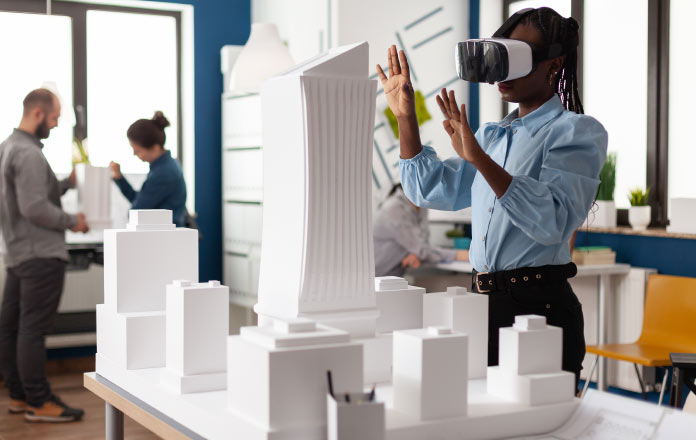The construction industry has always been a dynamic and innovative sector. From the adoption of heavy machinery to the introduction of digital tools, builders and engineers have embraced technology to improve efficiency and productivity. One of the latest technological revolutions in construction is Augmented Reality (AR). AR has rapidly transformed the construction projects that are planned, designed, and executed. This article explores how AR is creating a tangible impact within the construction site and driving the industry forward.
The Power of AR in Construction:
AR entails projecting digital information onto the physical environment. In the construction context, AR harnesses to overlay 3D models, data, and contextual information directly onto the job site, enabling builders and engineers to visualize, plan, and execute projects more effectively.
- Improved Design and Visualization: AR allows architects and engineers to bring blueprints and 3D models to life on the construction site. This immersive experience helps stakeholders gain a clearer understanding of the project’s scope, design, and spatial relationships. It empowers them to make well-informed decisions and revisions, reducing design errors and enhancing collaboration.
- Real-Time Data Integration: AR facilitates the real-time integration of critical project data. Construction professionals can access vital information such as plans, schedules, and material specifications instantly, enhancing communication and reducing the likelihood of errors.
- Enhanced On-Site Navigation: One of the most noticeable impacts of AR on construction sites is the improved navigation it offers. Workers can use AR-powered devices to locate specific areas, machinery, and tasks, reducing downtime and enhancing productivity.
- Precise Quality Control: AR aids quality control by overlaying project plans onto physical structures. It allows workers to identify deviations from the original design and make necessary adjustments on the spot, preventing costly rework.
- Safety and Training: Safety is paramount in construction. AR-based safety training modules immerse workers in potentially hazardous scenarios in a controlled, virtual environment, helping them better understand and follow safety protocols.
- Remote Collaboration: AR’s potential for remote collaboration is a game-changer. Project teams can share real-time on-site experiences with off-site experts and clients, enabling better decision-making, problem-solving, and stakeholder engagement.
- Progress Tracking: Project managers can use AR to track the construction’s progress in real-time, ensuring projects stay on schedule and within budget.
- Sustainable Building Practices: AR can assist in the optimization of energy efficiency and sustainable building practices, promoting eco-friendly construction.
The Transformation of Construction Sites:
AR is turning traditional construction sites into agile, data-driven environments. It empowers construction professionals with the tools to work more efficiently, accurately, and safely. These benefits significantly impact the construction industry, creating a positive steering force toward the future.
Benefits of AR on Construction Sites:
- Efficiency and Productivity: AR reduces project delays, increases productivity, and streamlines communication among construction teams, resulting in shorter project timelines.
- Enhanced Safety: Workers are better trained to handle potentially dangerous situations, reducing accidents and injuries.
- Cost Savings: By reducing errors, rework, and delays, AR contributes to significant cost savings.
- Improved Collaboration: AR fosters better collaboration among stakeholders, regardless of their geographic locations.
- Sustainability: AR can help promote sustainability through data-driven construction practices.
AR is rapidly transforming the construction industry, offering a variety of applications that improve efficiency, safety, and collaboration. As AR technology continues to evolve and becomes more accessible, it will play an increasingly significant role in shaping the future of construction. Builders, architects, and engineers who embrace AR today are at the forefront of this technological revolution, ensuring their projects are completed faster, more accurately, and with a heightened focus on safety and sustainability.
Read More





